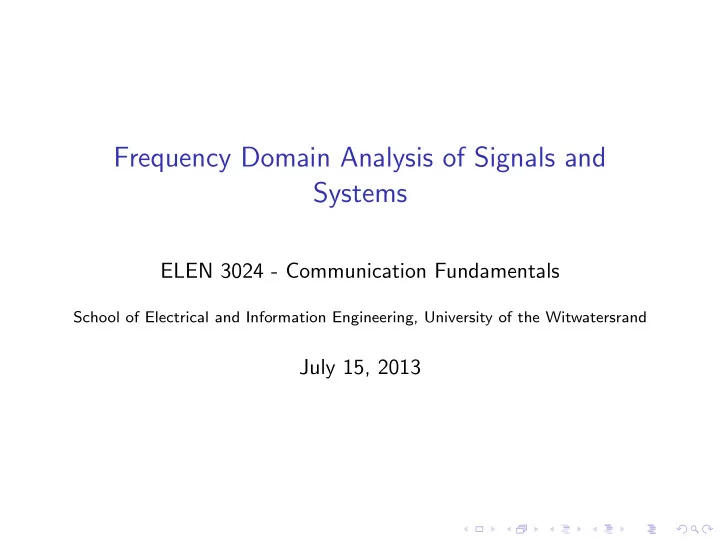

Frequency Domain Analysis of Signals and Systems ELEN 3024 - Communication Fundamentals School of Electrical and Information Engineering, University of the Witwatersrand July 15, 2013
Amplitude Modulation Proakis and Salehi, “Communication Systems Engineering” (2nd Ed.), Chapter 3
Overview Power content of various AM modulation schemes
3.2.1.2 Double-Sideband Supressed Carrier AM u ( t ) = A c m ( t ) cos(2 π f c t + φ ) Assume phase of signal set to zero → power in signal is independent of phase
3.2.1.2 Double-Sideband Supressed Carrier AM time-average autocorrelation function of u ( t ) T 1 � 2 R u ( τ ) = lim u ( t ) u ( t − τ )dt T T →∞ − T 2
3.2.1.2 Double-Sideband Supressed Carrier AM time-average autocorrelation function of u ( t ) T 1 � 2 R u ( τ ) = lim u ( t ) u ( t − τ )dt T T →∞ − T 2 T 1 � 2 A 2 = lim c m ( t ) m ( t − τ ) × T T →∞ − T 2 cos(2 π f c t ) cos(2 π f c ( t − τ ))dt T 1 � 2 A 2 = lim m ( t ) m ( t − τ ) × c 2 T T →∞ − T 2 [cos(4 π f c t − 2 π f c τ ) + cos(2 π f c τ )] dt A 2 = 2 R m ( τ ) cos(2 π f c τ ) c
3.2.1.2 Double-Sideband Supressed Carrier AM Used the fact that: T � 2 lim m ( t ) m ( t − τ ) cos(4 π f c t − 2 π f c τ )dt = 0 T →∞ − T 2 Because � ∞ −∞ m ( t ) m ( t − τ ) cos(4 π f c t − 2 π f c τ )dt � ∞ −∞ F [ m ( t − τ )] {F [ m ( t ) cos(4 π f c t − 2 π f c τ )] } ∗ df = � ∞ M ( f − 2 f c ) e − j 2 π fc t + M ( f +2 f c ) e j 2 π fc t � ∗ � −∞ e − j 2 π f τ M ( f ) = df 2 2 = 0
3.2.1.2 Double-Sideband Supressed Carrier AM � ∞ � M ( f − 2 f c ) e − j 2 π f c t + M ( f + 2 f c ) e j 2 π f c t � ∗ e − j 2 π f τ M ( f ) df = 0 2 2 −∞ Why?
3.2.1.2 Double-Sideband Supressed Carrier AM � ∞ � M ( f − 2 f c ) e − j 2 π f c t + M ( f + 2 f c ) e j 2 π f c t � ∗ e − j 2 π f τ M ( f ) df = 0 2 2 −∞ Why? M ( f ) limited to the frequency band [ − W , W ] and W ≪ f c , therefore no frequency overlap between M ( f ) and M ( f ± 2 f c )
3.2.1.2 Double-Sideband Supressed Carrier AM Fourier transform on both sides of: F ( A 2 F ( R u ( τ )) = 2 R m ( τ ) cos(2 π f c τ )) c A 2 S u ( f ) = 4 [ S m ( f − f c ) + S m ( f + f c )] c ⇒ power-spectral density of DSB-SC signal is the power-spectral density of the message shifted upward and downward by f c and scaled by A 2 c / 4.
3.2.1.2 Double-Sideband Supressed Carrier AM To obtain total power in modulated signal • Substitute τ = 0 in time-average autocorrelation function • integrate power-spectral density of modulated signal A 2 P u = 2 R m ( τ ) cos(2 π f c τ ) | τ =0 c A 2 = 2 R m (0) c A 2 = 2 P m c
3.2.1.2 Double-Sideband Supressed Carrier AM Example 3.2.2
3.2.2.2 Conventional Amplitude Modulation Conventional AM signal similar to DSB when m ( t ) is substituted with 1 + am n ( t ) P u = A 2 c 2 P m P m power in the message signal.
3.2.2.2 Conventional Amplitude Modulation For AM DSB FC: T 1 � 2 (1 + am n ( t )) 2 dt = lim P m T T →∞ − T 2 T 1 � 2 (1 + a 2 m 2 lim n ( t ))dt T T →∞ − T 2 Assuming average of m n ( t ) = 0. P m = 1 + a 2 P m n
3.2.2.2 Conventional Amplitude Modulation Hence P u = A 2 2 + A 2 c 2 a 2 P m n c First component → carrier Second component → information carrying component.
Recommend
More recommend